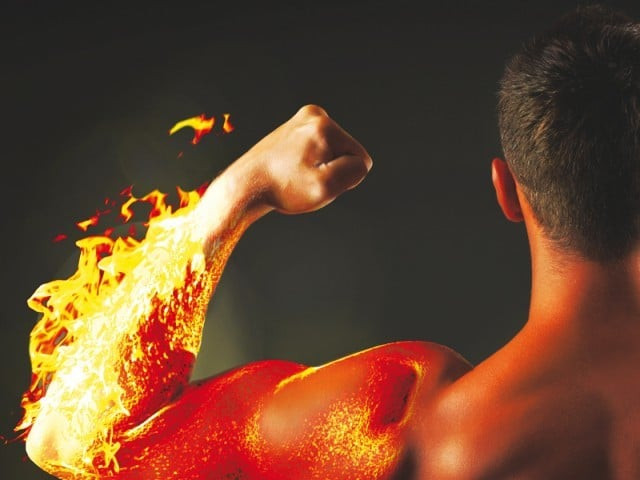6 muscle myths every man should know
We bust a few myths that can help sculpt the lean, toned body you’ve always wanted

STOCK IMAGE
Slow lifting builds huge muscles
Lifting slowly produces long workouts and that’s about it. University of Alabama researchers recently studied two groups of lifters doing a 29-minute workout. One group performed exercises using a five-second up phase and a 10-second down phase, the other, a more traditional approach of one-second up and one-second down. The faster group burnt 71 per cent more calories and lifted 250 per cent more weight than the slow lifters. “The best increases in strength are achieved by doing the up phase as rapidly as possible,” says Dr Gary Hunter, lead study author. “Lower the weight more slowly and under control.” There’s greater potential for muscle growth during the lowering phase, and when you lower with control, there’s less chance of injury.
More protein builds more muscle
Protein promotes the muscle-building process called protein synthesis, “but you don’t need exorbitant amounts to do this,” says Dr John Ivy, co-author of Nutrient Timing. Excess protein breaks down into amino acids and nitrogen, which are either excreted or converted into carbohydrates and stored. Ivy adds that what’re more important are the times you consume protein, and that you have the right balance of carbohydrates with it. Have a post-workout shake of three parts carbohydrates and one part protein. Eat a meal several hours later, and then reverse that ratio in your snack after another few hours, says Ivy. “This will keep protein synthesis going by maintaining high amino acid concentrations in the blood,” he explains.
Squats kill your knees
It’s a matter of knowing your form. A recent study in Medicine & Science in Sports & Exercise found that open-chain exercises – those in which a single joint is activated, such as the leg extension – are in fact more dangerous than closed-chain moves – those that engage multiple joints, such as the squat. The study found that squats cause much less uneven compression between the kneecap and thighbone, says Anki Stensdotter, the lead study author. “The knee joint is controlled by the quadriceps and the hamstrings. Balanced muscle activity keeps the knee in place and appears to be more easily attained in closed-chain exercises,” says Stensdotter. To squat safely, hold your back as upright as possible and lower your body until your thighs are parallel to the floor, or at least as far as you can go without discomfort in your knees.
Never exercise a sore muscle
Before you skip the gym, determine how sore you really are. “If your muscle is sore to the touch or the soreness limits your range of motion, it’s best that you give the muscle at least another day of rest,” says Dr Alan Mikesky, director of the human performance and biomechanics laboratory at Indiana University-Purdue University at Indianapolis. In less severe instances, an “active rest,” involving light cardio and stretching and even light-lifting can help ease some of the soreness. “Light activity stimulates blood flow through the muscles, which removes waste products to help in the repair process,” says Dr David Docherty, professor of exercise science at the University of Victoria in Canada. If you’re not sore to the touch and have your full range of motion, go to the gym, he advises.
Stretching prevents injuries
Researchers at the Centres for Disease Control and Prevention examined the relationship between stretching and injuries, and concluded that stretching during a warm-up has little effect on injury prevention. “Stretching increases flexibility, but most injuries occur within the normal range of motion,” says Dr Julie Gilchrist, one of the study’s researchers. “Stretching and warming up have just gone together for decades. It’s simply what’s done, and it hasn’t been approached through rigorous science.” Warming up is what prevents injury by slowly increasing your blood flow and giving your muscles a chance to prepare for the upcoming activity. To this end, Gilchrist suggests a thorough warm-up, as well as conditioning for your particular sport.
Always use free weights
Machines can build muscle better, especially when you need to isolate specific muscles after an injury, or when you’re inexperienced to perform a free-weight exercise. Do lat pull-downs to develop strength in this range of motion, says Dr Greg Haff, director of the strength research laboratory at Midwestern State University in Wichita Falls, Texas. “Initially, novice athletes will see benefits with either machines or free weights, but as you become more trained, free weights should make up the major portion of your training programme,” says Haff. Free-weight exercises impersonate athletic moves and generally activate more muscle mass. If you’re a seasoned lifter, free weights are your best tool to build strength and burn fat.
Published in The Express Tribune, July 10th, 2015.
Like Life & Style on Facebook, follow @ETLifeandStyle on Twitter for the latest in fashion, gossip and entertainment.


















COMMENTS
Comments are moderated and generally will be posted if they are on-topic and not abusive.
For more information, please see our Comments FAQ